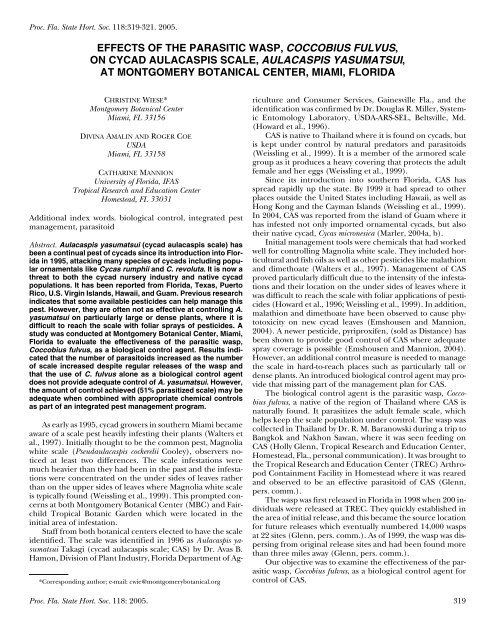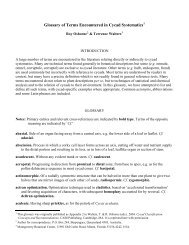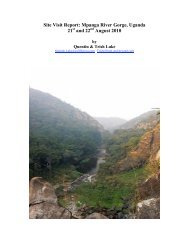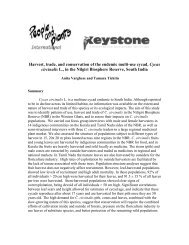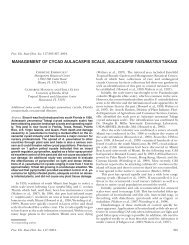effects of the parasitic wasp, coccobius fulvus - Cycad Specialist Group
effects of the parasitic wasp, coccobius fulvus - Cycad Specialist Group
effects of the parasitic wasp, coccobius fulvus - Cycad Specialist Group
You also want an ePaper? Increase the reach of your titles
YUMPU automatically turns print PDFs into web optimized ePapers that Google loves.
Proc. Fla. State Hort. Soc.<br />
118:319-321. 2005.<br />
EFFECTS OF THE PARASITIC WASP, COCCOBIUS FULVUS,<br />
ON CYCAD AULACASPIS SCALE, AULACASPIS YASUMATSUI,<br />
AT MONTGOMERY BOTANICAL CENTER, MIAMI, FLORIDA<br />
CHRISTINE<br />
WIESE*<br />
riculture and Consumer Services, Gainesville Fla., and <strong>the</strong><br />
Montgomery Botanical Center<br />
identification was confirmed by Dr. Douglas R. Miller, System-<br />
Miami, FL 33156<br />
ic Entomology Laboratory, USDA-ARS-SEL, Beltsville, Md.<br />
(Howard et al., 1996).<br />
DIVINA<br />
AMALIN<br />
AND ROGER<br />
COE<br />
USDA<br />
CAS is native to Thailand where it is found on cycads, but<br />
is kept under control by natural predators and parasitoids<br />
Miami, FL 33158<br />
(Weissling et al., 1999). It is a member <strong>of</strong> <strong>the</strong> armored scale<br />
group as it produces a heavy covering that protects <strong>the</strong> adult<br />
CATHARINE<br />
MANNION<br />
University <strong>of</strong> Florida, IFAS<br />
Tropical Research and Education Center<br />
Homestead, FL 33031<br />
female and her eggs (Weissling et al., 1999).<br />
Since its introduction into sou<strong>the</strong>rn Florida, CAS has<br />
spread rapidly up <strong>the</strong> state. By 1999 it had spread to o<strong>the</strong>r<br />
places outside <strong>the</strong> United States including Hawaii, as well as<br />
Hong Kong and <strong>the</strong> Cayman Islands (Weissling et al., 1999).<br />
Additional index words. biological control, integrated pest<br />
management, parasitoid<br />
In 2004, CAS was reported from <strong>the</strong> island <strong>of</strong> Guam where it<br />
has infested not only imported ornamental cycads, but also<br />
<strong>the</strong>ir native cycad, Cycas micronesica (Marler, 2004a, b).<br />
Abstract. Aulacaspis yasumatsui (cycad aulacaspis scale) has<br />
been a continual pest <strong>of</strong> cycads since its introduction into Florida<br />
in 1995, attacking many species <strong>of</strong> cycads including popular<br />
ornamentals like Cycas rumphii and C.<br />
revoluta.<br />
It is now a<br />
Initial management tools were chemicals that had worked<br />
well for controlling Magnolia white scale. They included horticultural<br />
and fish oils as well as o<strong>the</strong>r pesticides like malathion<br />
and dimethoate (Walters et al., 1997). Management <strong>of</strong> CAS<br />
threat to both <strong>the</strong> cycad nursery industry and native cycad proved particularly difficult due to <strong>the</strong> intensity <strong>of</strong> <strong>the</strong> infesta-<br />
populations. It has been reported from Florida, Texas, Puerto<br />
Rico, U.S. Virgin Islands, Hawaii, and Guam. Previous research<br />
indicates that some available pesticides can help manage this<br />
pest. However, <strong>the</strong>y are <strong>of</strong>ten not as effective at controlling A.<br />
yasumatsui on particularly large or dense plants, where it is<br />
difficult to reach <strong>the</strong> scale with foliar sprays <strong>of</strong> pesticides. A<br />
study was conducted at Montgomery Botanical Center, Miami,<br />
Florida to evaluate <strong>the</strong> effectiveness <strong>of</strong> <strong>the</strong> <strong>parasitic</strong> <strong>wasp</strong>,<br />
Coccobius <strong>fulvus</strong>, as a biological control agent. Results indicated<br />
that <strong>the</strong> number <strong>of</strong> parasitoids increased as <strong>the</strong> number<br />
tions and <strong>the</strong>ir location on <strong>the</strong> under sides <strong>of</strong> leaves where it<br />
was difficult to reach <strong>the</strong> scale with foliar applications <strong>of</strong> pesticides<br />
(Howard et al., 1996; Weissling et al., 1999). In addition,<br />
malathion and dimethoate have been observed to cause phytotoxicity<br />
on new cycad leaves (Emshousen and Mannion,<br />
2004). A newer pesticide, pyriproxifen, (sold as Distance) has<br />
been shown to provide good control <strong>of</strong> CAS where adequate<br />
spray coverage is possible (Emshousen and Mannion, 2004).<br />
However, an additional control measure is needed to manage<br />
<strong>of</strong> scale increased despite regular releases <strong>of</strong> <strong>the</strong> <strong>wasp</strong> and <strong>the</strong> scale in hard-to-reach places such as particularly tall or<br />
that <strong>the</strong> use <strong>of</strong> C. <strong>fulvus</strong> alone as a biological control agent<br />
does not provide adequate control <strong>of</strong> A. yasumatsui. However,<br />
<strong>the</strong> amount <strong>of</strong> control achieved (51% parasitized scale) may be<br />
adequate when combined with appropriate chemical controls<br />
as part <strong>of</strong> an integrated pest management program.<br />
dense plants. An introduced biological control agent may provide<br />
that missing part <strong>of</strong> <strong>the</strong> management plan for CAS.<br />
The biological control agent is <strong>the</strong> <strong>parasitic</strong> <strong>wasp</strong>, Coccobius<br />
<strong>fulvus</strong>,<br />
a native <strong>of</strong> <strong>the</strong> region <strong>of</strong> Thailand where CAS is<br />
naturally found. It parasitizes <strong>the</strong> adult female scale, which<br />
As early as 1995, cycad growers in sou<strong>the</strong>rn Miami became<br />
aware <strong>of</strong> a scale pest heavily infesting <strong>the</strong>ir plants (Walters et<br />
al., 1997). Initially thought to be <strong>the</strong> common pest, Magnolia<br />
white scale (Pseudaulacaspis cockerelii Cooley), observers noticed<br />
at least two differences. The scale infestations were<br />
much heavier than <strong>the</strong>y had been in <strong>the</strong> past and <strong>the</strong> infestations<br />
were concentrated on <strong>the</strong> under sides <strong>of</strong> leaves ra<strong>the</strong>r<br />
than on <strong>the</strong> upper sides <strong>of</strong> leaves where Magnolia white scale<br />
is typically found (Weissling et al., 1999). This prompted concerns<br />
at both Montgomery Botanical Center (MBC) and Fairchild<br />
Tropical Botanic Garden which were located in <strong>the</strong><br />
initial area <strong>of</strong> infestation.<br />
Staff from both botanical centers elected to have <strong>the</strong> scale<br />
identified. The scale was identified in 1996 as Aulacaspis yasumatsui<br />
Takagi (cycad aulacaspis scale; CAS) by Dr. Avas B.<br />
Hamon, Division <strong>of</strong> Plant Industry, Florida Department <strong>of</strong> Ag-<br />
helps keep <strong>the</strong> scale population under control. The <strong>wasp</strong> was<br />
collected in Thailand by Dr. R. M. Baranowski during a trip to<br />
Bangkok and Nakhon Sawan, where it was seen feeding on<br />
CAS (Holly Glenn, Tropical Research and Education Center,<br />
Homestead, Fla., personal communication). It was brought to<br />
<strong>the</strong> Tropical Research and Education Center (TREC) Arthropod<br />
Containment Facility in Homestead where it was reared<br />
and observed to be an effective parasitoid <strong>of</strong> CAS (Glenn,<br />
pers. comm.).<br />
The <strong>wasp</strong> was first released in Florida in 1998 when 200 individuals<br />
were released at TREC. They quickly established in<br />
<strong>the</strong> area <strong>of</strong> initial release, and this became <strong>the</strong> source location<br />
for future releases which eventually numbered 14,000 <strong>wasp</strong>s<br />
at 22 sites (Glenn, pers. comm.). As <strong>of</strong> 1999, <strong>the</strong> <strong>wasp</strong> was dispersing<br />
from original release sites and had been found more<br />
than three miles away (Glenn, pers. comm.).<br />
Our objective was to examine <strong>the</strong> effectiveness <strong>of</strong> <strong>the</strong> <strong>parasitic</strong><br />
<strong>wasp</strong>, Coccobius <strong>fulvus</strong>,<br />
as a biological control agent for<br />
*Corresponding author; e-mail: cwie@montgomerybotanical.org<br />
control <strong>of</strong> CAS.<br />
Proc. Fla. State Hort. Soc. 118: 2005. 319
320<br />
Materials and Methods<br />
Study Plants. Five groups <strong>of</strong> three replications (three<br />
plants) were selected for inclusion in <strong>the</strong> study. Plants were<br />
selected based on past observations <strong>of</strong> routinely heavy scale<br />
infestations. Study plants were located at Montgomery Botanical<br />
Center, Miami, Fla. They included <strong>the</strong> following species:<br />
Cycas bougainvilleana K.D. Hill, C. thouarsii R. Br. ex Gaudich,<br />
C. panzihuensis L. Zhou and S.Y. Yang, and C. revoluta Thunb.<br />
Release Method. In week one <strong>of</strong> <strong>the</strong> study, one vial containing<br />
100 <strong>wasp</strong>s was opened to release <strong>the</strong> <strong>wasp</strong>s on each plant<br />
in <strong>the</strong> first group <strong>of</strong> three plants. Wasps were released on <strong>the</strong><br />
same three plants in weeks two and three <strong>of</strong> <strong>the</strong> study. In week<br />
four <strong>of</strong> <strong>the</strong> study, <strong>wasp</strong>s were released in <strong>the</strong> same manner on<br />
<strong>the</strong> three plants in <strong>the</strong> second group <strong>of</strong> study plants. Wasps<br />
were again released on all three plants in <strong>the</strong> second group<br />
once per week in weeks five and six <strong>of</strong> <strong>the</strong> study. Releases were<br />
staggered in this manner until each group <strong>of</strong> three plants had<br />
undergone three releases <strong>of</strong> <strong>the</strong> <strong>wasp</strong>.<br />
Chemical Treatment. In order to learn how <strong>the</strong> <strong>wasp</strong> would<br />
be affected by chemical applications, a single treatment was<br />
done with pyriproxifen, a product that has been used to manage<br />
CAS. Pyriproxifen (Distance) was applied with a foliar<br />
spray according to <strong>the</strong> label rate (12 oz product /100 gal) to<br />
all study plants once at month 6 <strong>of</strong> <strong>the</strong> 8-month study.<br />
Data Ga<strong>the</strong>red and Analyzed. One week after <strong>the</strong> third release<br />
<strong>of</strong> <strong>the</strong> <strong>wasp</strong>, 10 leaflets were removed at random from<br />
each plant. The number <strong>of</strong> live scale insects (males and females)<br />
and parasitized scale were recorded. Each plant was<br />
sampled twice more during <strong>the</strong> 8-month study. Each time a<br />
plant was sampled, 10 leaflets were removed and number <strong>of</strong><br />
live scale and parasitized scale were recorded and percent<br />
parasitized scale was calculated.<br />
Results and Discussion<br />
Average percent parasitized scale was 51% (Table 1). This<br />
would not be considered a high enough percent parasitized<br />
scale for biological control to be a successful method to control<br />
CAS alone. However, percentage <strong>of</strong> parasitized scale was<br />
significant enough to consider biological control to be a valid<br />
part <strong>of</strong> an integrated pest management program. If <strong>the</strong> <strong>wasp</strong><br />
is released in an area where CAS is treated only with those<br />
chemicals compatible with <strong>the</strong> <strong>wasp</strong>, <strong>the</strong> <strong>wasp</strong> could be an<br />
important component <strong>of</strong> a long-term CAS management<br />
program.<br />
Our results also indicate that number <strong>of</strong> parasitoids rise<br />
and fall with <strong>the</strong> number <strong>of</strong> total scale (males and females).<br />
Results indicated that <strong>the</strong>re was, at best, approximately one<br />
parasitoid present for every 10 scale (Fig. 1). This relationship<br />
held true during much <strong>of</strong> <strong>the</strong> 8-month study as <strong>the</strong> scale population<br />
rose and fell. This relationship indicates that <strong>the</strong> population<br />
<strong>of</strong> parasitoids will never be enough to control <strong>the</strong><br />
population <strong>of</strong> CAS alone, but will be consistently parasitizing<br />
a percentage <strong>of</strong> <strong>the</strong> scale all <strong>the</strong> time.<br />
Researchers have observed in <strong>the</strong> past that <strong>the</strong> <strong>wasp</strong> seems<br />
to control <strong>the</strong> scale very well when <strong>the</strong> scale population is<br />
high, but that control drops when <strong>the</strong> scale population declines.<br />
Our results confirm past observations on <strong>the</strong> efficiency<br />
<strong>of</strong> <strong>the</strong> <strong>wasp</strong> as a biological control agent.<br />
The results <strong>of</strong> <strong>the</strong> chemical application <strong>of</strong> pyriproxifen on<br />
study plants were inconclusive. There was very little scale observed<br />
and almost no female scale observed both immediately<br />
before and after <strong>the</strong> chemical application. Earlier observations<br />
in o<strong>the</strong>r trials indicate that pyriproxifen is compatible<br />
with <strong>the</strong> <strong>parasitic</strong> <strong>wasp</strong> (C. Mannion, pers. comm.). Fur<strong>the</strong>r<br />
investigation is needed to confirm this.<br />
Table 1. Number <strong>of</strong> parasitized scale per number females and percent parasitized scale for 8 months. Number parasitized scale and percent parasitized scale<br />
is for a single replication <strong>of</strong> 10 leaflets.<br />
Date<br />
Number parasitized scale<br />
per number <strong>of</strong> females<br />
Percent<br />
parasitized scale Date<br />
Number parasitized scale<br />
per number <strong>of</strong> females<br />
Percent<br />
parasitized scale<br />
12/12/2003 66/182 36 3/19/2004 0/0<br />
1-----<br />
12/12/2003 4/5 80 3/19/2004 0/0<br />
1-----<br />
12/12/2003 15/32 47 3/19/2004 0/0<br />
1-----<br />
12/24/2003 66/199 33 3/19/2004 0/0<br />
1-----<br />
12/24/2003 11/27 41 3/19/2004 0/0<br />
1-----<br />
12/24/2003 88/140 63 3/19/2004 0/0<br />
1-----<br />
12/31/2003 0/0 -----1<br />
3/26/2004 4/10 40<br />
12/31/2003 10/10 100 3/26/2004 0/0<br />
1-----<br />
12/31/2003 10/10 100 3/26/2004 0/0<br />
1-----<br />
1/9/2004 184/322 57 4/19/2004 0/0<br />
1-----<br />
1/9/2004 18/18 100 4/19/2004 7/48 15<br />
1/9/2004 27/27 100 4/19/2004 0/34 0<br />
1/21/2004 74/78 95 5/6/2004 0/44 0<br />
1/21/2004 13/56 23 5/6/2004 0/0<br />
1-----<br />
1/21/2004 18/52 35 5/6/2004 0/0<br />
1-----<br />
2/6/2004 59/87 68 7/9/2004 0/10 0<br />
2/6/2004 46/95 48 7/9/2004 0/0<br />
1-----<br />
2/6/2004 32/36 89 7/9/2004 0/8 0<br />
2/20/2004 26/52 50 7/16/2004 0/0<br />
1-----<br />
2/20/2004 7/18 39 7/16/2004 0/11 0<br />
2/20/2004 109/218 50 7/16/2004 0/5 0<br />
3/5/2004 33/33 100 7/23/2004 0/0<br />
1-----<br />
3/5/2004 46/46 100 7/23/2004 0/0<br />
1-----<br />
3/5/2004 127/142 89 7/23/2004 0/0<br />
1-----<br />
1-----<br />
no female scale present.<br />
Proc. Fla. State Hort. Soc. 118: 2005.
Fig. 1. Average number total scale and average number parasitized scale<br />
during <strong>the</strong> 8-month study. Average number is <strong>the</strong> average <strong>of</strong> three replications.<br />
Each replication included a sample <strong>of</strong> 10 leaflets.<br />
CAS is a serious pest <strong>of</strong> cycads. It has had a detrimental impact<br />
on <strong>the</strong> ornamental cycad industry and is now also a concern<br />
for native cycad populations around <strong>the</strong> world. It is<br />
important at this time to use an approach to control CAS that<br />
will be effective in <strong>the</strong> long-term. Insects can acquire resistance<br />
to chemicals over time. The most effective control for<br />
CAS will likely involve several types <strong>of</strong> control methods including<br />
cultural, chemical and biological control. Our study<br />
suggests that while <strong>the</strong> <strong>parasitic</strong> <strong>wasp</strong> does not provide a high<br />
enough level <strong>of</strong> control to be effective against CAS alone, it<br />
could be an important part <strong>of</strong> a long-term integrated pest<br />
management program to control CAS.<br />
Literature Cited<br />
Emshousen C. and C. Mannion. 2004. Taming Asian cycad scale. The <strong>Cycad</strong><br />
Newsletter 27(1):8-10.<br />
Howard, F. W., T. Weissling, and D. Hull. 1996. New armored scale insect introduction<br />
in Miami area. TropicLine 9(2).<br />
Marler, T. 2004a. Fighting back. Pacific Daily News. 13 March.<br />
Marler, T. 2004b. <strong>Cycad</strong> scale attacking Guam plants. Pacific Daily News. 25<br />
September.<br />
Walters, T., E. Shroyer, and L. Anderson. 1997. Scale and south Florida Cycas.<br />
The <strong>Cycad</strong> Newsletter 20(1):13-15.<br />
Weissling, T. J., F. W. Howard, and A. B. Hamon. 1999. <strong>Cycad</strong> aulacaspis<br />
scale, Aulacaspis yasumatsui Takagi (Insecta: Homoptera: Sternorrhyncha:<br />
Diaspididae). Florida Coop. Ext. Service Publication document EENY-<br />
096. July.<br />
Proc. Fla. State Hort. Soc. 118: 2005. 321


